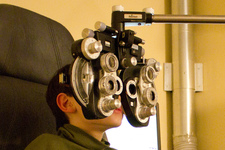
While having lunch at a local eatery today, I noticed my eye doctor dining at a nearby table. As I consumed my chicken tacos, a particular thought came to mind -- our classrooms need to be more like a visit to my eye doctor’s office.
Wait. What? That’s right. My eye doctor. See, my eye doctor is awesome. I don’t dread my annual eye examination. I actually look forward to the appointment. As someone who has worn glasses/contact lenses since the beginning of the fourth grade, I’ve had a lot of eye examinations in my life. But never had I looked forward to a check-up until I began seeing my current doctor. Why? Because my doctor is encouraging. He makes me feel like I get the correct answers to his questions -- questions that don’t have right or wrong answers. For those of you who aren’t familiar with a visit to the eye doctor, here’s how it works. You sit in the chair and look through what’s called a phoropter, a weird-looking machine containing a whole bunch of interchangeable lenses (see the image above). In order to determine your prescription, the doctor goes through a series of questions I call “Which Looks Better?” For each eye, the doctor has you look through two different lenses in the phoropter, asking you which lens gives you clearer vision. Depending on your answer, the doctor changes the lenses to try and find the perfect lens combination for you. Here’s how the conversation sounds with my doctor: Doctor: “OK, which do you like better? Lens 1 or 2?” Me: “1.” Doctor: “Good. Now if I change it to this, which is better? 1 or 2?” Me: “Ummm…..2.” Doctor: “Good. Good. How about this? 1 or 2?” Me: “Still 2.” Doctor: “Good! Now, if I change this here, is it clearer or just a little smaller?” Me: “Smaller.” Doctor: “Good! Good! OK, great job! That’s it. Things look good.” The doctor asks me a question, I give him an answer, and he says, “Good job!” Remember, there is no correct answer to any of these questions. I’m simply answering based on what my eyes tell me looks good. Yet the doctor praises me. And each time he does, I feel a little prouder about myself. I think, “Alright! I’m acing this test!” And that’s just it -- it isn’t a test!!! I’m doing what I’m supposed to do, but I still receive positive feedback for my efforts. Here lies the connection to our classrooms. How often do we praise our students for doing what they’re supposed to do? How often do we provide positive feedback for the expected, unglamorous things that go on during the school day? Like taking out a notebook without talking. “Great job, Noah. I appreciate you getting your notebook out quietly.” Yes, Noah was supposed to do this without being disruptive, but how much more encouraged is Noah feeling after this comment? Like turning in an assignment on time. “Thank you, Grace. Great job getting your work done.” Yes, Grace was supposed to turn it in on time, but how much more likely is she to do it again because of this praise? Like showing up at school. “Hey, Trevor. I’m glad you’re here today.” Yes, Trevor is supposed to be at school. But how much more will he look forward to coming tomorrow because of a comment like this? I look forward to going to my eye doctor, because he makes me want to go. He does so by being encouraging, by offering praise, even for actions that are expected. How much more would our students want to come to our classrooms if they knew they could expect this same kind of encouragement? Give it a try. It’ll make a huge difference in the lives of your students.
6 Comments
JoAnn Androff
7/6/2015 03:39:06 pm
Positive reinforcement. Such a powerful tool. I truly have every intention to use it, and then somehow, I find myself focusing on those negative behaviors that need to be addressed. I vow to put more energy in to recognizing the positive and hopefully, it will cause a decrease in the negative.....Thanks Brent, for reminding us of the importance of making these positive connections with our kids.
Reply
Tracy Zordan
7/6/2015 11:14:43 pm
With the pace of a 50 min class, the focus is often on trying to keep the students moving in the right direction. Sometimes it feels like herding cats and this often means NOT focusing on the positive. New goal for next year - try to acknowledge something positive in each class. Thanks for opening our eyes ;)
Reply
Pablo Lindell
7/15/2015 01:47:09 pm
Great insight and showing a true depth and understanding to what makes people tick, passive reinforcement.
Reply
Your comment will be posted after it is approved.
Leave a Reply. |
About BrentBrent has worked in the field of education as a teacher and administrator for 28 years. A former elementary school teacher and principal, he is currently Coordinator of Elementary Education in the Murrieta Valley Unified School District in Southern California. Read more about Brent here. Brent on X (Twitter)Archives
May 2024
Categories
All
|
Photos from somegeekintn, woodleywonderworks, Joybot, British Council Singapore, jseliger2, berkuspic, toddwendy, Alexandra E Rust, skippyjon, crdotx, tharrin, roybuloy, .FuturePresent., Just some dust, frankpierson, Jair Alcon Photography, Luigi Mengato, Muffet, stevendepolo, Pilar Soro, Sander van der Wel, jblyberg, jonathangarcia, DraXus, angeloangelo, Sthetic


 RSS Feed
RSS Feed
